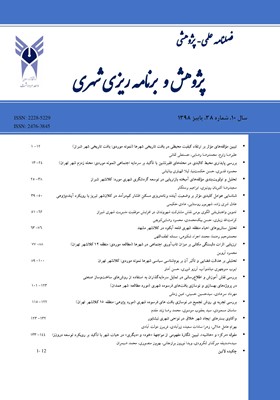تحلیل استراتژیهای توسعه شهر ایلام با استفاده از مدل AHP
محورهای موضوعی : فصلنامه علمی و پژوهشی پژوهش و برنامه ریزی شهریعظیم علیشائی 1 , ببراز کریمی 2
1 - مربی و عضو هیات علمی گروه جغرافیا دانشگاه پیام نور، تهران، ایران
2 - مدرس گروه شهرسازی واحد صفاشهر، دانشگاه آزاد اسلامی، صفاشهر، ایران
کلید واژه: ایلام, تحلیل سلسله مراتبی, استراتژیهای توسعه شهر,
چکیده مقاله :
استراتژیهای توسعه شهر از دیدگاههای جدید و تاثیرگذار در بهبود روند برنامهریزی شهر است. هدف پژوهش تعیین استراتژیهای توسعه شهری ایلام و اولویتبندی آنها با استفاده از مدل AHP است. پژوهش حاضر با ماهیت کاربردی و روش تحقیق ترکیبی (پیمایش و توصیفی- تحلیلی) به تعیین استراتژیهای توسعه شهری ایلام میپردازد. در این پژوهش ابتدا 6 استراتژیاصلی، ساماندهی فضایی، تقویت اقتصاد شهری، زیستپذیری اجتماعی، دسترسی پایدار، محیط زیست و حکمروایی خوب شهر، به همراه استراتژیهای فرعی بر اساس درخت سلسله مراتبی ترسیم گردید و پس از تهیه پرسشنامه از متخصصان و مدیران شهری خواسته شد تا بر اساس مقایسه زوجی اولویتها را مشخص سازند. در کل نتایج حاصل از تلفیق معیارها و زیر معیارها نشان میدهد که کسب درآمدهای پایدار با میانگین وزنی 365/0 اولویت اول، کاهش آلودگی هوا با امتیاز 336/0 دارای اولویت دوم، عدالت فضایی با ضریب اهمیت 3/0 اولویت سوم و در راستای دسترسی پایدار شهر، ارتقاء حمل و نقل عمومی با میانگین وزنی 298/0 در اولویت چهارم برنامهریزی قرار داشته و اولویت پنجم برنامهریزی نیز تدوین چشمانداز با امتیاز 284/0 است و بسترسازی تعاملات اجتماعی در اولویت آخر برنامهریزی قرار گرفته است.
By change of the city planning viewpoints, the common procedures which is related to city development preparation and approval has changed as well. These procedures will be reviewed and the city development strategies are the new and effective viewpoints for improving city planning flow. The aim of this project are determining Ilam city development strategies and prioritizing them by AHP. The current Ilam programs are physical and static, they are not made based on social and economic aspects and they are not responsive to the current needs of this city, the goals which are expected to be very low. In this project, first six main strategies are planned which are include spatial organizing, urban economic reinforcing, social livability, stable accessing, environment, good city ruling and sub-strategies based on the hierarchical tree. After preparing the questionnaire be asked to professionals and city managers to identify priorities based o paired comparison. With regard to the strategic planning and its systematic approach, the obtained weighted coefficient has priority for integrating actions. The results of integrating criteria and sub criteria show that the first priority is sustainable income, the second is decrease of air pollution, the third is spatial equity.


